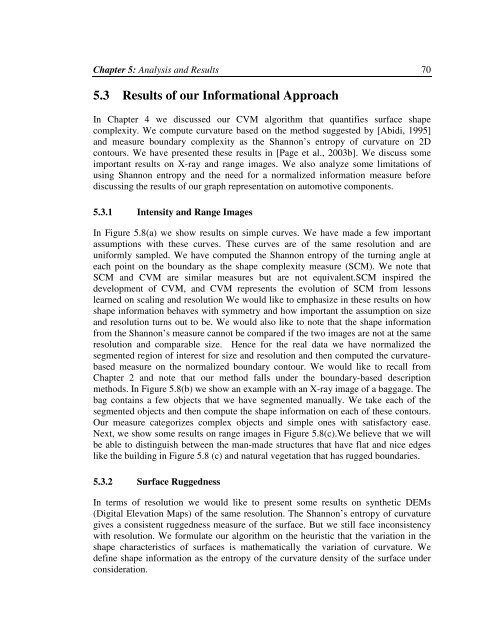To the Graduate Council: I am submitting herewith a thesis written by ...
To the Graduate Council: I am submitting herewith a thesis written by ...
To the Graduate Council: I am submitting herewith a thesis written by ...
You also want an ePaper? Increase the reach of your titles
YUMPU automatically turns print PDFs into web optimized ePapers that Google loves.
Chapter 5: Analysis and Results 705.3 Results of our Informational ApproachIn Chapter 4 we discussed our CVM algorithm that quantifies surface shapecomplexity. We compute curvature based on <strong>the</strong> method suggested <strong>by</strong> [Abidi, 1995]and measure boundary complexity as <strong>the</strong> Shannon’s entropy of curvature on 2Dcontours. We have presented <strong>the</strong>se results in [Page et al., 2003b]. We discuss someimportant results on X-ray and range images. We also analyze some limitations ofusing Shannon entropy and <strong>the</strong> need for a normalized information measure beforediscussing <strong>the</strong> results of our graph representation on automotive components.5.3.1 Intensity and Range ImagesIn Figure 5.8(a) we show results on simple curves. We have made a few importantassumptions with <strong>the</strong>se curves. These curves are of <strong>the</strong> s<strong>am</strong>e resolution and areuniformly s<strong>am</strong>pled. We have computed <strong>the</strong> Shannon entropy of <strong>the</strong> turning angle ateach point on <strong>the</strong> boundary as <strong>the</strong> shape complexity measure (SCM). We note thatSCM and CVM are similar measures but are not equivalent.SCM inspired <strong>the</strong>development of CVM, and CVM represents <strong>the</strong> evolution of SCM from lessonslearned on scaling and resolution We would like to emphasize in <strong>the</strong>se results on howshape information behaves with symmetry and how important <strong>the</strong> assumption on sizeand resolution turns out to be. We would also like to note that <strong>the</strong> shape informationfrom <strong>the</strong> Shannon’s measure cannot be compared if <strong>the</strong> two images are not at <strong>the</strong> s<strong>am</strong>eresolution and comparable size. Hence for <strong>the</strong> real data we have normalized <strong>the</strong>segmented region of interest for size and resolution and <strong>the</strong>n computed <strong>the</strong> curvaturebasedmeasure on <strong>the</strong> normalized boundary contour. We would like to recall fromChapter 2 and note that our method falls under <strong>the</strong> boundary-based descriptionmethods. In Figure 5.8(b) we show an ex<strong>am</strong>ple with an X-ray image of a baggage. Thebag contains a few objects that we have segmented manually. We take each of <strong>the</strong>segmented objects and <strong>the</strong>n compute <strong>the</strong> shape information on each of <strong>the</strong>se contours.Our measure categorizes complex objects and simple ones with satisfactory ease.Next, we show some results on range images in Figure 5.8(c).We believe that we willbe able to distinguish between <strong>the</strong> man-made structures that have flat and nice edgeslike <strong>the</strong> building in Figure 5.8 (c) and natural vegetation that has rugged boundaries.5.3.2 Surface RuggednessIn terms of resolution we would like to present some results on syn<strong>the</strong>tic DEMs(Digital Elevation Maps) of <strong>the</strong> s<strong>am</strong>e resolution. The Shannon’s entropy of curvaturegives a consistent ruggedness measure of <strong>the</strong> surface. But we still face inconsistencywith resolution. We formulate our algorithm on <strong>the</strong> heuristic that <strong>the</strong> variation in <strong>the</strong>shape characteristics of surfaces is ma<strong>the</strong>matically <strong>the</strong> variation of curvature. Wedefine shape information as <strong>the</strong> entropy of <strong>the</strong> curvature density of <strong>the</strong> surface underconsideration.
















